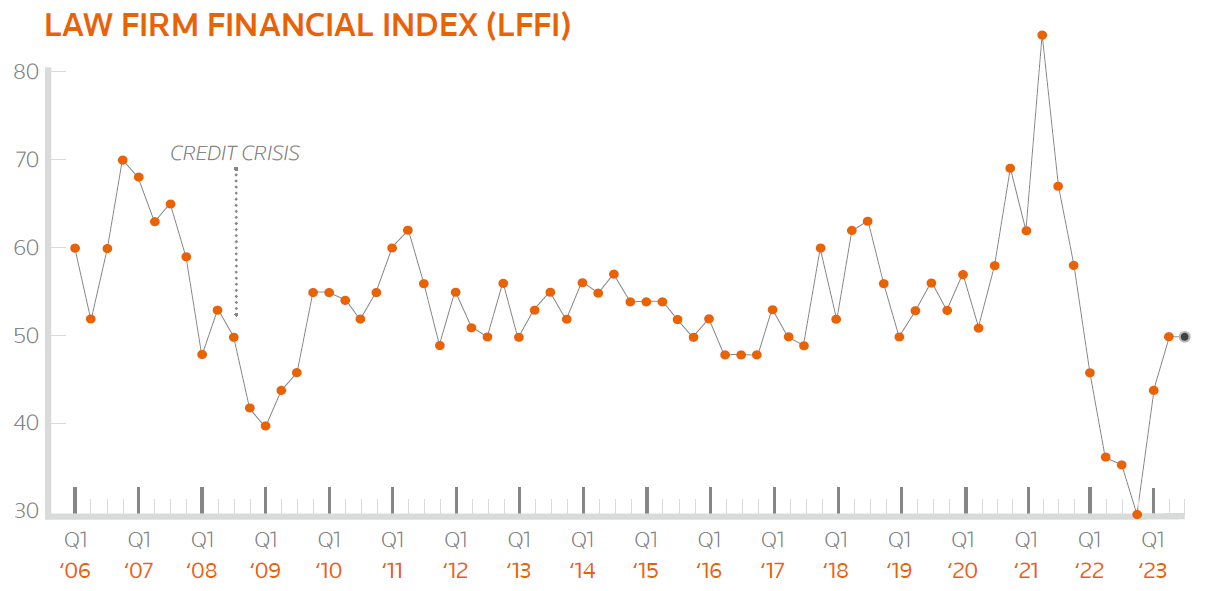The Law Firm Financial Index, a key measurement of law firm performance, remained at its six-quarter high in Q3, as industry focus now turns to wringing out a more profitable 2023
The latest Thomson Reuters Institute Law Firm Financial Index (LFFI) reveals that law firms have slowed down their hiring levels in the third quarter of 2023, after two years of rapid headcount growth, in order to improve their profitability.
The new report also shows that firms have increased their worked rates — those agreed-upon rates with clients — negotiating closer to their standard rates for their legal services. The Index, which measures the drivers of law firm profitability, such as rates, demand, productivity, and expenses, remained at its six-quarter high of 50 points, indicating a continuing positive outlook for the industry.
Key takeaways in Q3
The report showed several important developments that contributed to this strong showing, including:
-
-
- The LFFI score held at its previous levels, just short of the historical average score but well above recent all-time lows.
- Smaller-scale hiring efforts were enacted this year, with all firms bringing in smaller associate classes and some of the largest segments aggressively pulling back on hiring of first-year associates.
- Am Law 100 firms are shaping up to be the profit growth leaders this year on the back of high-rate growth and conservative hiring decisions, while Midsize law firms are on track to break even. The Am Law Second Hundred is looking to fall behind its 2022 profits this year.
-
The report also reveals that different segments of the law firm market have experienced different levels of performance and challenges. The Am Law 100 firms, the largest and most profitable firms, have been the first to return to profit growth on a rolling 12-month average, thanks to their efforts to control their expenses and maintain their rates. Midsize firms, which have been growing more aggressively in non-first-year associate titles, have also improved their profitability from their lows of a couple of quarters ago and are now outperforming the Am Law Second Hundred. The Second Hundred segment, on the other hand, has struggled to balance its demand and expenses, and seem unlikely to reach the same level of profitability as it did in 2022.

One of the factors that has been holding back some firms from achieving higher profitability is the lack of a recovery in the transactional practice area, which typically drives demand for legal services in periods of economic growth. The report shows that the average daily demand per lawyer — which reflects how each segment is handling the balance of supply and demand of their lawyers — in September has surpassed 2022’s levels, but it has remained well below that of 2021. However, the report also notes that some law firms have been able to keep their demand strong by relying on counter-cyclical practices, such as bankruptcy, litigation, and regulatory, which tend to boom during periods of economic hardship and uncertainty.
As 2023 reaches its end, the report suggests that there are some factors that could help or hinder law firms’ profitability. On the positive side, firms will be measuring their future performance against the lowest baselines in the LFFI’s history, which could give them a boost. On the negative side, each segment faces a unique challenge: the Am Law 100 needs to increase its demand, Midsize firms need to manage their expenses, and the Second Hundred needs to find a clear strategy.
The report concludes that the segments that made bold strategic decisions — in whichever direction — are seeing them pay off, while the ones that did not are falling behind.







